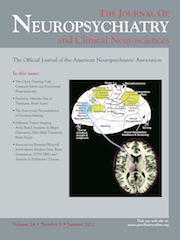Associations Between Bilateral Subthalamic Nucleus Deep Brain Stimulation (STN-DBS) and Anxiety in Parkinson’s Disease Patients: A Controlled Study
Abstract
The authors explored the associations between subthalamic nucleus deep brain stimulation (STN-DBS) and anxiety in Parkinson’s disease (PD) patients. Recent research suggests that anxiety may be one of the earliest manifestations of PD; however, the lack of a dopamine-medication control group is a major limitation of these studies. Authors paired a group of 31 bilateral STN-DBS PD patients (STN-DBS group) with 31 dopamine-medicated PD patients (Medication-control group) and used various psychological assessment scales for group evaluations. These were completed 1 month preoperatively, and 3 weeks, 5 weeks, 2 months, 4 months, 7 months, and 13 months postoperatively. As compared with the Medication group, the STN-DBS group improved in motor functioning and general status after 1 week Stimulator Power–On; State-Anxiety improved significantly at 1 week and 1 month after Stimulator Power–On, but was not significant at the subsequent time-points. Anxiety scores remained stable before 3rd-month Stimulator Power–On, but got worse after that time. In the STN-DBS group, S–AI was positively related to motor symptoms and life quality preoperatively and 4 months postoperatively, but, in the Medication group, this correlation existed throughout the study. PD-related anxiety decreased in STN-DBS patients because of the improvement in motor function for a short time; however, as the voltages and pulse-widths grew higher with time, the PD-related anxiety became worse.



